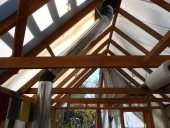Hi all,
I just got back from Oceti Sakowin camp, and have a small report back from my point of view.
I just stayed for one day to bring supplies, and witnessed and was oriented in a few things that could use some clarification for those who may want to visit.
Firstly, there is a strong request to come self-sufficient. If you come to help, plan on bringing all your own food, water shelter and tools. Don't arrive with the assumption that others will take care of you if you come to help, because that's not helpful! Of course the camp takes care of people in need, and everyone in camp will extend hospitality if you are in need. And this camp is here to protect the water, not to take care of travelers. The best help we can be as guests is to give more than we take. Water, food, shelter, firewood, electricity and tools are particularly scarce resources.
Secondly, there is a strong need for more help in winterization! When I was there it looked like about half of people in camp were still in their summer tent accommodations. These are rapidly becoming risky, so if you go make sure you can connect with a camp that has access to tipis, wall tents, and other heated indoor spaces for sleeping. I know that RMHs will help with the winterization effort, and I think the priority is to put up enough structures that can be heated in the first place. If you want to go and help with RMHs, ask what the immediate need is first, so that winterization efforts can be coordinated well.
Thirdly, it's a native-led space. We all have lots of cool ideas of how to help, and there are lots of really knowledgeable native elders here who have heard cool ideas from lots of people as well. It's their space, so follow their direction so that all our efforts to help can coordinate well and actually be helpful. If you go, first ask what the need is rather than assuming they'll need your expertise. As an example, I have a friend who's a skilled paramedic and intended to go as a field medic, but turns out that they have the medics that they need and he was most helpful in winterization efforts, building a bunch of stuff. He happily worked his tail off for a week instead of practicing medicine, and left the space much improved. Also, ask permission from the local native people to build stuff, dig clay, cut plants, or use any on-site resource. The camp is here to protect the land and the water, because the US government and DAPL didn't ask before building their pipeline. We are there as guests of the local people. Always ask before taking, digging, chopping, or building something!
Finally, there is an issue with half-finished projects in camp. It is awesome to have people with specialized knowledge come in to camp and donate their time and effort to improve the place. And if those people can't stay long enough to see their projects thru, oftentimes no one who stays in camp has the specialized skills to finish the project. For example, they are building sheds to house their medical supplies. Due to a lack of tools, the build went slower than projected. The carpenter who designed and was directing the build had to leave before the roof was on, and the building sat for three days without a roof or a plan, until another carpenter arrived in camp who could teach people how to build the roof. There are a lot of unfinished projects like this around camp, waiting for a specialist to come along. But again, ask what the need is before jumping in on an unfinished project!
I hope lots of people can go. This is a beautiful community of people from all backgrounds. Everyone is super welcoming and respectful. This is probably the first time I've been in a native-centered space where I felt completely welcome as a white person. It was such a great experience to come to camp and be greeted by smiling strangers of all backgrounds. Water is Life!












